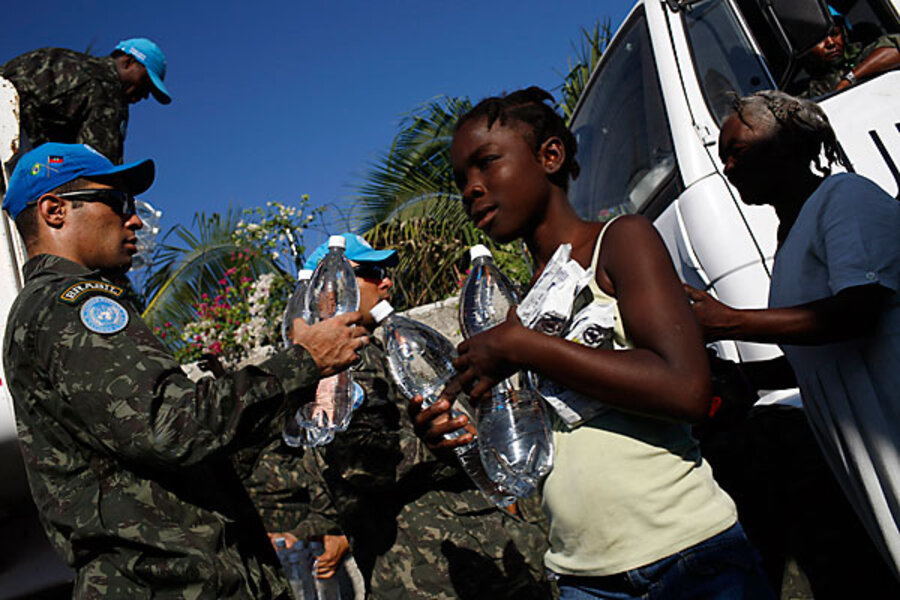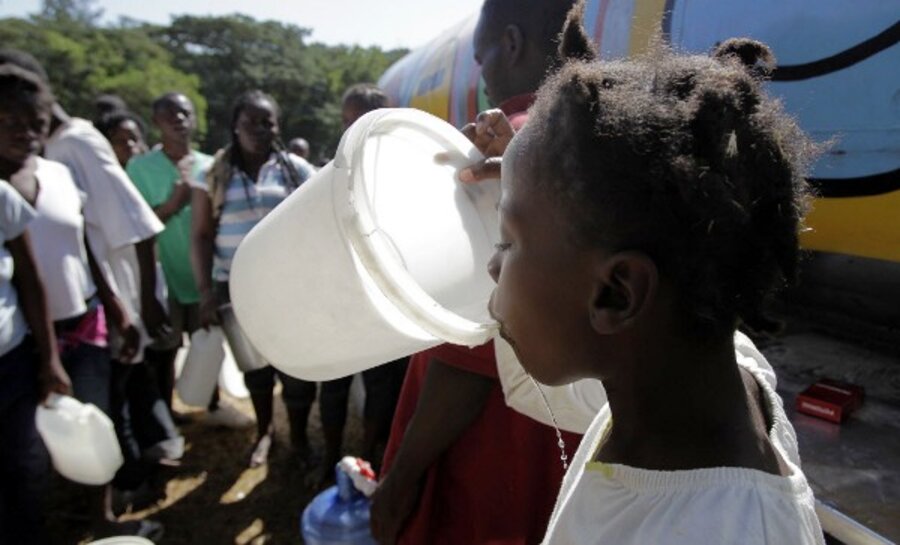With plastic and cardboard, Haitians build communities
| Port-au-Prince, Haiti
It’s nearing lunch time at the Primatur Gardens refugee camp in Haiti’s capital, and the 4,000 homeless arrayed under plastic tarps, umbrellas, and tree shade are getting hungry.
“There’s no food or potable water provided here, and we have to cut the trees to be able to cook, but at least we are all alive,” says Jeanne-Baptiste Vania, as she breaks spaghetti in two and drops it into a bubbling pot of fish stock.
The matriarch says her family of 17 lost their home and all their possessions “the day the earth shook.” Not knowing what else to do, they came that night to the gardens of the prime minister’s residence – and here they have scratched out their meager existence ever since.
Ten days after Haiti’s devastating earthquake, hundreds of thousands of Haitians in the capital of Port–au-Prince are living in open-air camps – with no prospects for moving into shelter and out from under the tropical country’s hot sun any time soon.
Wealthy left, leaving city to the poor
The city’s wealthy and relatively well-off have mostly fled to farms or family outside the collapsed capital, and that has left Port-au-Prince – already home to many poor – a city of the poorest.
Relief officials estimate that at least 250 camps like Primatur have sprung up around the capital, becoming home to hundreds of thousands of Haitians who either lost their shelter in the 7.0 temblor or remain too afraid to return to destroyed neighborhoods.
Official help comes sporadically to the camps, residents say, but in most cases potable water is still unavailable and food lands in plastic bowls on an “every family for itself” basis. On Thursday the Red Cross delivered supplies to Primatur – plastic sheeting, the rudiments of a health clinic – and United Nations Blue Helmets provide security from a truck parked outside the camp’s perimeter.
But mostly, Primatur’s residents say they feel abandoned.
“The government, they really don’t care a bit about us,” says Magda Jeidy, who squats under a tarp with her parents and a dozen other relatives – all of whom ran from their contorting home and watched as the earthquake collapsed it and then sent it sliding into a ravine. “We saw the Americans and some French here once, but if we waited for our government we’d all die.”
The archbishop mourned
Port-au-Prince continues to bury its dead, both the poor and the prominent. On Saturday, the archbishop of Port-au-Prince, Joseph Serge Miot, who died in the collapse of the city’s cathedral, was honored with a funeral on the cathedral grounds attended by numerous dignitaries and hundreds of Catholic faithful.
Standing under a withering sun, the crowd sang hymns in French and Latin, and repeated the Lord’s Prayer. When the officiating priest declared “Your love is stronger than death,” a hushed “Amen!” rippled through the assembly.
Despite the strong sentiment of abandonment expressed in the open-air camps, officials and some relief workers insist the kinks in supply delivery are being ironed out, with medical supplies especially getting out as the bottlenecks of the first week are cleared out. And US officials say the situation will improve further as more US military and reinforcements for the United Nations peacekeeping mission arrive.
US-UN coordination still a problem
Still, coordination of the massive international relief effort – especially between the United States and the UN – remains problematic enough that the US and the UN again on Thursday took a stab at defining roles and responsibilities. US and UN Representatives in Port-au-Prince signed a new “statement of principles” – a response in part to recent controversy over the US military’s management of the Port-au-Prince airport.
Some foreign governments and relief organizations have complained of too much priority given to US military flights.
The “statement of principles” also stipulates that the Haitian government has “primary responsibility” for response to the earthquake. Making that point officially seemed aimed at reminding both the world and Haiti’s citizens that Haiti has what the State Department calls a “sovereign government.”
But no one seems to believe the fiction that the Haitian government, with its devastated ministries and undermanned police, is in charge. Certainly no one at Primatur camp does.
“The truth is that the government is still not up and running, so we had to get this all going ourselves,” says Joël Jean-Baptiste, a development specialist who has become Primatur’s unofficial manager. “You have to have organization when you have 4,000 people, and the government wasn’t up to it.”
Self-appointed organizing committee
Since the camp sprang up spontaneously the night of January 12, Mr. Jean-Baptiste and a self-appointed organizing committee has completed a census of the camp – taking special note of the children under 4 years old – and created a crude camp ID card. Volunteers have been rounded up to perform everything from the menial – litter clean-up – to the specialized, like the nurse and medical student manning the camp’s makeshift clinic. When petty theft became a problem, a citizens patrol was set up and a 10 p.m. curfew was set.
Jean-Baptiste – whose own home was not destroyed in the quake – says he hopes to spread the idea that when the government doesn’t function, the people become the government.
“This is state property and we respected it, “ he says, “But once there was a disaster and the government vanished, it became the right of the people to occupy this property and use it.”
Short term, he says Primatur despite its shortcomings might serve as a model for other refugee camps. Singling out the “spirit of community” he sees sprouting here, Jean-Baptiste says that “perhaps in a small way we can also contribute to the whole new way of thinking Haiti will need as we rebuild it.”







